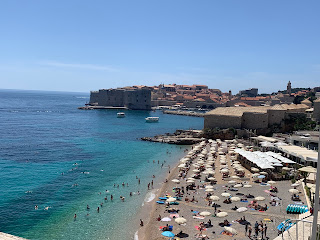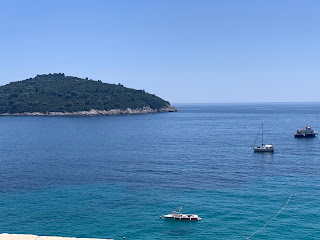Mostar. I can't make sense of it.
 |
| Taken from the historic Mostar bridge |
I remember watching news about the Bosnian War in the early 1990s and reading about the genocide in Srebrenica and the campaigns of ethnic cleansing in Bosnia and Kosovo. Up until now I had thought of the war as part of a long history of ethnic hatred between Serbians and Croatians, with the Bosnians suffering attack and genocide as Serbia sought expansion into a Greater Serbia.
Well, I still think kind of along those lines just because I need to make sense of something, but the whole is so much more complex and convoluted. After listening to our guide’s perspective on the war and visiting the War and Genocide Museum, I realize I can't even begin to wrap my head around the complexity of the ethnic divisions here and how those divisions impacted what people did. Mostar was attacked first by Bosnian Serbs and later besieged by the Bosnian Croat Army for ten months. But just saying that is still missing all sorts of information… I’ve rewritten this too many times and tried to jam information into every sentence. I have to accept I just can’t summarize or make sense of things.
 |
| The symbol of Mostar - the old bridge divides the city east and west |
In Mostar the front line wasn't exactly at the bridge, but a few streets further out-- a neighborhood street that still divides Mostar's western side, the old city that is predominantly Muslim, from Mostar's eastern side, which is the Bosnian Croat neighborhood. Up until recently, people didn't cross the street without trepidation, and even now there are people who have never crossed the bridge, which is the symbolic division-- Bosnian Muslims on one side and Bosnian Croats on the other. And the divisions still aren't healed. We learned that even now, although everyone goes to the same school, there are three different history curriculums taught.
 |
| The neighborhood street that divides Mostar -- there are still holes from bullets and shrapnel, as there are on many buildings throughout the city |
And it gets confusing again. Our guide, Sheva was born and raised in Mostar. He is a Herzegovinian Muslim who fought in Mostar during the war with a group that included men from different backgrounds and ethnicities. I'm not sure how people made their choices. How did the unit get people from different backgrounds with all of this ethnic division? I just don't know or understand, and I get more confused as I try to unravel things. The only thing I know is what Sheva showed us, which is where the city graveyards are filled with Muslim and non-Muslim graves alike. Almost all the deaths read "1993."
The city is in a valley surrounded by rocky hills and it was besieged by the Bosnian Croat forces from June 1993 to April 1994. People couldn’t get food, water, or medicine from outside the town. People were shot going to the river for water and they had to fish using explosives. The bridges were blown up, including the old bridge, which was eventually repaired after the war. Throughout the city, there are still damaged buildings and some bombed out buildings remain partially standing, but many places around the old town have been restored or rebuilt. It amazes me how much has been rebuilt, especially when you think that it's not even been thirty years, and 70% of the city was destroyed.
 |
| Another view of Mostar from the old bridge |
 |
| The cobbled streets of the old town |
 |
| One of the many mosques as you walk through Mostar. The graveyard we visited was just across the street on the other side of the minaret. |
 |
| Bosnian coffee before our tour |








































